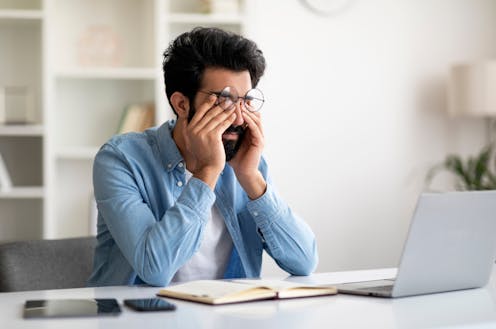How to protect your eyes in the digital age – expert in eye and vision science
- Written by Daniela Oehring, Associate Professor in Optometry, University of Plymouth

In an era where screens dominate our daily lives, a silent epidemic is sweeping the globe. Digital eye strain[1], a condition once relegated to the fringes of occupational health concerns, has emerged as a significant public health issue affecting millions worldwide. As our reliance on digital devices for work, education and social interaction intensifies, so too does the risk to our ocular health.
Recent studies paint a stark picture. Up to 50% of computer users[2] could develop digital eye strain. This condition, characterised by a range of ocular and visual symptoms, including dryness, watering, itching, burning and blurred or even double vision, is not merely a matter of discomfort; it can indicate potentially chronic issues[3] that can significantly affect a person’s quality of life and productivity.
The COVID pandemic[4] has exacerbated this trend, with lockdowns and social distancing measures driving screen time to unprecedented levels.
A marked increase in digital device usage[5] during the pandemic correlates with a surge in ocular surface diseases, visual disturbances and digital eye strain.
The unseen toll of digital dependence
But what exactly happens to our eyes when we stare at screens for long periods? The answer lies in the intricate biology of our visual system. When focusing on digital displays, our blink rate falls, and our eyes strain to maintain focus on near objects for extended periods. Reduced blinking and sustained near focus triggers a cascade[6] of ocular issues, from mild irritation to chronic dryness.
The symptoms of digital eye strain are diverse and often insidious. They range from the immediately noticeable, such as eye fatigue, dryness, and blurred vision, to more subtle signs like headaches and neck pain. While often transient, these symptoms can become persistent and debilitating if left unchecked.
Contrary to popular belief, the blue light emitted by screens[7] is not the primary cause of digital eye strain. While blue light can contribute to eye fatigue and disrupt sleep patterns, there’s no conclusive evidence that it causes permanent eye damage. The real villains are poor ergonomics[8], extended near-focus work and reduced blinking[9].
So, how can we protect our vision in this screen-centric world? The solution lies in a multifaceted approach that combines behavioural changes, environmental adjustments, and, when necessary, medical interventions.
Protective measures
The 20-20-20 rule[10] is a simple but effective strategy for protecting your eyes against digital strain.
Every 20 minutes, take a 20-second break to focus on something 20 feet away. This brief respite allows your eye muscles to relax, reducing the strain associated with constant near focus work. While widely recommended, it’s worth noting that the efficacy of this specific rule[11] hasn’t been rigorously studied, but the principle of taking frequent breaks is sound.
Environmental factors[12] play a fundamental role in maintaining ocular comfort during screen use[13]. Proper lighting, adequate humidity and good air quality can significantly affect eye health. Use adjustable lamps to direct light away from your eyes, use a humidifier to maintain moisture levels and consider an air purifier to remove irritating airborne particles.
Ergonomic adjustments[14] are equally important. Position your screen at arm’s length and slightly below eye level to reduce neck strain. Increase font sizes to minimise squinting and ensure your chair provides proper back support for good posture.
For those experiencing persistent symptoms, professional help is key. Eye care practitioners can provide comprehensive exams to identify underlying issues such as refractive errors[15] – common eye conditions where the eye’s shape prevents light from focusing correctly on the retina, causing blurry vision – or dry eye disease. Ocular specialists can prescribe targeted treatments, from specialised eye-wear to medications that address specific eye health concerns.
Emerging therapies offer hope for more effective management of digital eye strain. Drugs called novel TRPM8 agonists[16] show promise in relieving dry eye discomfort by activating cooling receptors on the eye’s surface. Meanwhile, wearable biosensors[17] that fit as a patch under the eye or attached to contact lenses are being developed to monitor tear fluid biomarkers in real time. Tears can reflect the health of the ocular surface and potentially the whole body, so this technological development could transform the diagnosis and treatment of ocular surface diseases.
Irreplaceable assets
In this digital age, it’s important to take measures to protect our vision. By recognising the signs of digital eye strain, implementing protective strategies, and seeking timely professional care, we can reduce the risks associated with our screen-dependent lifestyles.
The challenge of digital eye strain is not insurmountable. With awareness, education and a commitment to ocular health, we can continue exploiting digital technology’s benefits without compromising our vision. As we look to the future, integrating eye-friendly technologies and ergonomic designs in our digital devices may offer additional layers of protection.
In the meantime, remember to take breaks, blink often and don’t hesitate to seek professional help if you experience persistent symptoms. In doing so, you’ll be taking crucial steps towards ensuring clear, comfortable vision.
References
- ^ Digital eye strain (bmjophth.bmj.com)
- ^ Up to 50% of computer users (bmjophth.bmj.com)
- ^ chronic issues (doi.org)
- ^ COVID pandemic (doi.org)
- ^ increase in digital device usage (doi.org)
- ^ triggers a cascade (doi.org)
- ^ blue light emitted by screens (doi.org)
- ^ poor ergonomics (doi.org)
- ^ extended near-focus work and reduced blinking (doi.org)
- ^ 20-20-20 rule (doi.org)
- ^ efficacy of this specific rule (doi.org)
- ^ Environmental factors (doi.org)
- ^ during screen use (doi.org)
- ^ Ergonomic adjustments (doi.org)
- ^ refractive errors (www.nei.nih.gov)
- ^ novel TRPM8 agonists (doi.org)
- ^ wearable biosensors (doi.org)







